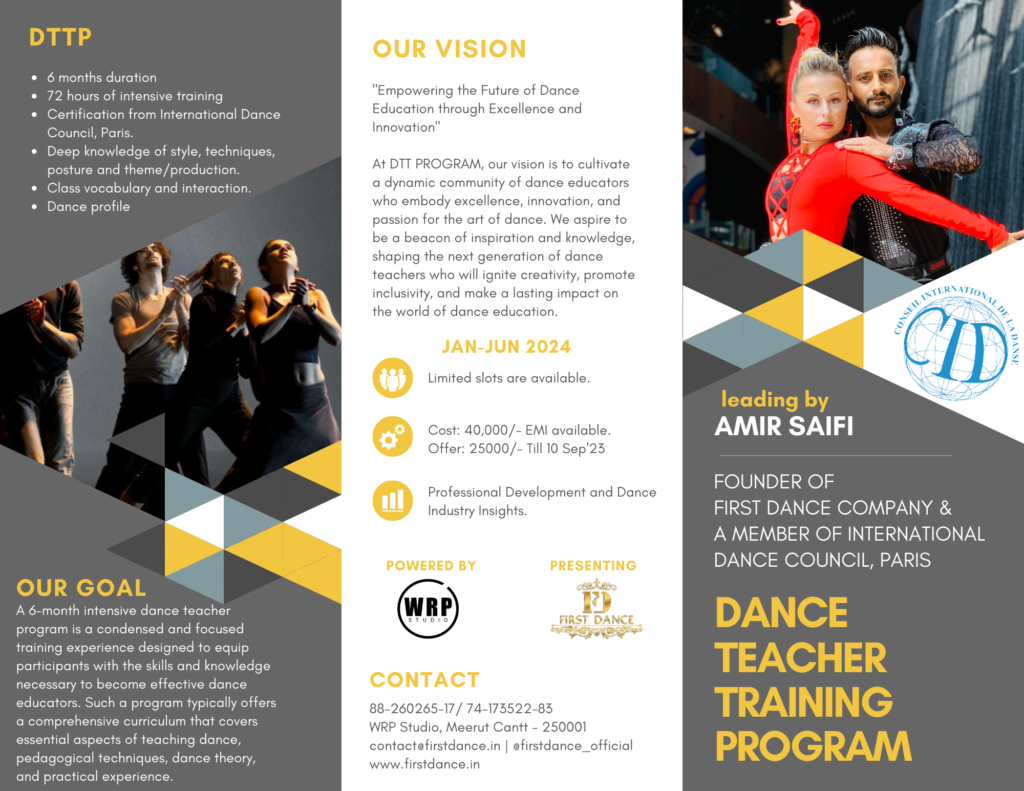First Dance Company

Dance Teacher Training Program By
Amir Saifi (A member of the International Dance Council, Paris)
The dance teacher training program has been designed to prepare individuals to become proficient educators in the field of dance. These programs typically focus on developing both the technical and pedagogical skills required to teach contemporary dance to students of varying ages and skill levels. Here are some key aspects you might find in such a program:
Curriculum: The curriculum of a contemporary dance teacher training program often covers a wide range of topics, including dance technique, choreography, dance history, anatomy, music for dance, improvisation, and teaching methods. The goal is to provide a well-rounded education that equips future teachers with a deep understanding of the art form.
Technical Training: Intensive training in contemporary dance technique is a crucial component of these programs. Students will work on improving their own dance skills while also learning how to effectively communicate and demonstrate these techniques to their students.
Pedagogy: Teaching methods and pedagogy are central to these programs. Students learn how to design lesson plans, create effective exercises, give constructive feedback, and adapt their teaching to different learning styles and levels.
Choreography: Contemporary dance teacher training often includes instruction in choreography. This involves understanding the creative process, exploring different choreographic techniques, and learning how to guide students in creating their own dances.
Practical Experience: Many programs offer opportunities for students to gain practical teaching experience. This could involve observing experienced teachers, leading warm-ups and exercises, and eventually teaching full classes under supervision.
Dance History and Theory: Understanding the history and theory of contemporary dance is important for teachers to provide context and depth to their instruction. This might cover the evolution of contemporary dance, influential choreographers, and significant works.
Anatomy and Injury Prevention: Knowledge of anatomy and how the body works is important for teaching dance safely and preventing injuries. Teacher training programs often include courses on anatomy, kinesiology, and injury prevention.
Professional Development: DTTP program offers guidance on building a career as a dance teacher, including networking, resume-building, and understanding the dance education industry.
Certification: The teacher training program offers certification upon completion from International Dance Council, Paris. This certification can vary in terms of recognition and requirements, so it’s important to research the program’s credentials.
Auditions and Requirements: DTTP program require applicants to audition or submit a portfolio showcasing their dance skills and sometimes their teaching potential.
Remember that the field of dance education is dynamic, and programs may vary widely in their approach and offerings. It’s important to choose a program that aligns with your goals and aspirations as a dance teacher.
Vision Statement
“Empowering the Future of Dance Education through Excellence and Innovation”
At DTT PROGRAM, our vision is to cultivate a dynamic community of dance educators who embody excellence, innovation, and passion for the art of dance. We aspire to be a beacon of inspiration and knowledge, shaping the next generation of dance teachers who will ignite creativity, promote inclusivity, and make a lasting impact on the world of dance education.
Our program envisions a future where dance educators are equipped with a profound understanding of dance techniques, pedagogical methodologies, and the rich history and cultural diversity that shape the world of dance. We strive to nurture a learning environment that fosters creativity, critical thinking, and the development of leadership skills, preparing our graduates to lead and guide their students with confidence and empathy.
Through collaborative learning experiences, hands-on training, and exposure to cutting-edge teaching methods, our program envisions dance educators who are adaptable, technologically savvy, and capable of tailoring their instruction to meet the diverse needs of their students. We are committed to promoting holistic growth, nurturing both the artistic and personal development of our trainees.
As advocates for inclusivity, our vision encompasses dance educators who celebrate cultural diversity, challenge stereotypes, and create safe spaces where every individual can express themselves authentically through movement. By instilling values of respect, professionalism, and ethical conduct, we aim to inspire our graduates to be role models who contribute positively to the dance community.
In pursuit of our vision, we are dedicated to fostering a lifelong commitment to learning and growth among our graduates. We envision them engaging in continuous professional development, seeking new insights, and staying at the forefront of advancements in dance education. Ultimately, our program’s vision is to leave an indelible mark on the dance education landscape by producing educators who illuminate the path of dance for generations to come.

